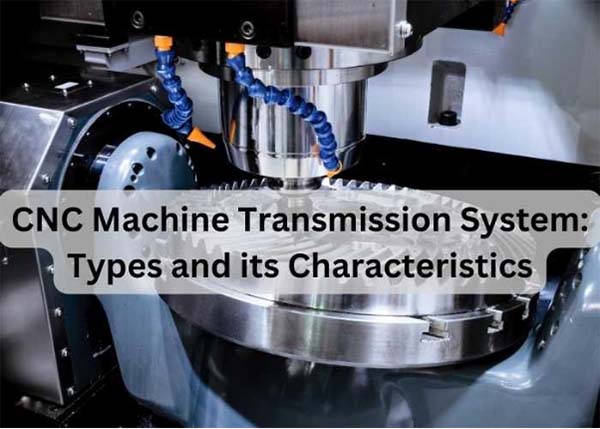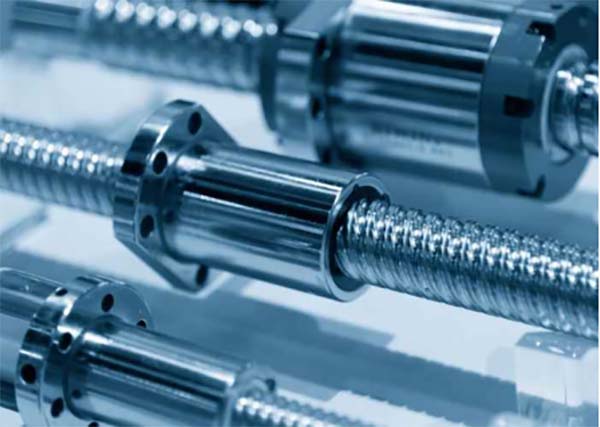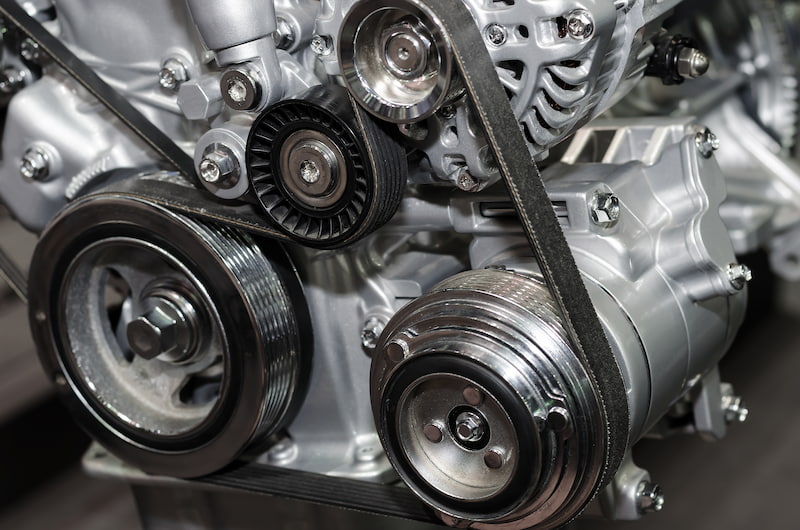A CNC (Computer Numerical Control) machine is a computer-controlled manufacturing tool used to produce parts and products with high precision and accuracy.
It operates through a series of pre-programmed commands that dictate the movements of the machine's tools and equipment. These instructions are created using specialized software based on CAD (Computer-Aided Design) models.
CNC machines use various transmissions to convert power from the motor to controlled movement in different axes (X, Y, Z, and sometimes more).
You’ll learn about the CNC machine transmission system in detail in this article.So, let’s dive in!

The transmission system in a CNC (Computer Numerical Control) machine is responsible for converting the rotational motion of the motor into precise movement along different axes (X, Y, Z, etc.). These movements allow cutting or other tools mounted on the machine to operate precisely according to programmed instructions.
Several types of transmission systems are commonly used in CNC machines. Let’s explore them in detail.
Ball screw transmission is a critical component in many CNC (Computer Numerical Control) machines, primarily used for converting rotational motion into precise linear motion. It's a popular choice due to its high efficiency and accuracy. Here's how it works:
● Screw Shaft: This is a threaded shaft with helical grooves that guide the ball bearings' movement.
● Ball Bearings: These are placed within the helical grooves and circulate between the nut and the screw shaft. They reduce friction and facilitate smooth motion.
● Nut: The nut contains the ball bearings and is fitted onto the screw shaft. As the shaft rotates, the nut moves along the shaft, converting the rotational motion into linear motion.
1. Rotational Motion Conversion: When the motor turns the screw shaft, the ball bearings within the grooves help the nut move along the shaft.
2. Linear Motion Generation: The linear movement of the nut along the shaft translates into movement in a specific direction. This movement is utilized for various purposes in CNC machines, such as accurately positioning the cutting tool or workpiece.
● High Precision: Ball screw transmissions are known for their accuracy, making them suitable for CNC machines requiring fine tolerances and precise movements.
● Efficiency: They offer better efficiency than other transmission systems, reducing power loss due to friction.
Ball screw transmissions are widely used in CNC machines where precision is crucial. They are found in CNC mills, lathes, and other equipment where accurate positioning and smooth linear motion are necessary.

Like ball screw transmissions, lead screw transmissions are mechanisms used in CNC (Computer Numerical Control) machines to convert rotational motion into linear motion. Here's an oerview of lead screw transmissions:
● Screw Shaft: The lead screw is a threaded shaft, similar to a bolt, with a single continuous thread.
● Nut: The nut is threaded internally to match the screw's thread. It's mounted on the shaft and moves along as the screw rotates.
1. Rotational Motion Conversion: When the motor rotates the lead screw, the nut travels along the shaft, converting the rotational motion into linear motion.
2. Linear Motion Generation: This linear movement positions and moves various components in CNC machines, such as the tool or workpiece, along a particular axis.
● Simplicity: Lead screw transmissions are simpler in structure than ball screws, making them cost-effective and easier to manufacture.
● Suitability for Less Demanding Applications: They can be suitable for applications where extreme precision isn't required, such as in simpler CNC machines or certain movements that don't need highly accurate positioning.
Lead screw transmissions find application in less demanding CNC machines or in situations where high precision is not the primary concern. They're used in some low-cost or hobbyist CNC equipment.
While lead screw transmissions are simpler and more affordable than ball screws, they might not offer the same level of precision. Their usage depends on the specific requirements of the CNC application and the necessary tolerances for the movements.
Rack and pinion transmission is a mechanical system used in CNC (Computer Numerical Control) machines to convert rotational motion into linear motion. Here's an overview of how it works:
● Rack: A straight bar with teeth or grooves along its length. The rack is fixed, and the teeth mesh with the pinion's gear.
● Pinion: A small gear that engages with the teeth on the rack. When the pinion rotates, it causes the rack to move linearly.
1. Rotational Motion Conversion: The motor turns the pinion gear.
2. Linear Motion Generation: As the pinion gear rotates, it engages with the teeth on the rack, causing the rack to move in a linear direction. This movement positions different components in the CNC machine along a specific axis.
● Speed and Long-Distance Movement: Rack and pinion systems are advantageous for rapid movements covering longer distances, making them suitable for larger CNC machines or movements that require speed over precision.
● Simple Design: The system is relatively simple in design and assembly.
Rack and pinion transmissions are commonly used in larger CNC machines, especially in scenarios where rapid movements and covering longer distances are essential, such as in some CNC routers used for woodworking or in large-scale manufacturing where high speed is required.
The choice of transmission system in a CNC machine often depends on the application's specific requirements, balancing factors like precision, speed, and the nature of the operations to be performed.

Belt drive transmission in CNC (Computer Numerical Control) machines is a system that uses belts and pulleys to transfer rotational motion from the motor to linear motion in the machine's axes. Here's an overview of this transmission system:
● Belts: Made of materials like rubber or polymer, belts connect the pulleys to transmit power. They are available in different types, such as timing belts or V-belts.
● Pulleys: These are wheels with a grooved surface that the belts sit in. The belts connect the pulleys on the motor and the axis to be moved.
1. Rotational Motion Conversion: The motor rotates one of the pulleys connected by the belt to another.
2. Linear Motion Generation: As the connected pulley rotates, it moves the belt, which moves the pulley on the axis, causing linear movement. This movement positions the components in the CNC machine along a specific axis.
● Cost-Effective: Belt drive systems are often more affordable than other transmission systems like ball screws or rack and pinion.
● Quieter Operation: They operate more quietly than systems with gears and ball screws.
Belt drive transmissions are often used in CNC machines where high precision isn’t as critical, such as some entry-level or hobbyist CNC routers or smaller-scale machines. They suit applications where cost and simplicity are more important than extreme accuracy.
The choice of transmission system in a CNC machine depends on the application's specific requirements, balancing factors like precision, speed, load capacity, and cost-effectiveness.
Several factors affect the CNC transmission system. Let’s discuss a few of them.
● High Precision Needs: If the application demands high precision, such as in aerospace or medical industries, transmission systems like ball screws are preferred due to their accuracy.
● Less Precision Required: For applications where lower precision is acceptable, cost-effective solutions like belt drives or lead screws might be used.
● Rapid Movements: Systems like rack and pinion are suitable for rapid movements and covering longer distances due to their speed efficiency.
● Slower but Precise Movements: Ball screws offer higher precision but might sacrifice speed compared to other systems.
● Heavy Loads: Transmission systems must support the required load without compromising movement or causing damage. Robust systems like ball screws, rack, and pinion might be preferred for heavy loads.
● Budget Constraints: Some systems, like belt drives or lead screws, are more cost-effective than ball screws or rack and pinion systems. If precision isn’t the highest priority, cost-effective options might be chosen.
● Maintenance Needs: Systems that require less maintenance, like belt drives or lead screws, might be preferred in scenarios where frequent upkeep isn’t feasible or cost-effective.
● Longevity: The longevity and wear characteristics of the transmission system are important factors in choosing a system that ensures consistent performance over time.
● Specific Industry Requirements: Different industries might have unique needs. For instance, woodworking CNC machines prioritize speed over precision, while high-precision metalworking requires absolute accuracy.
● The selection of the transmission system is often a balance among these factors, where the specific requirements of the CNC application, including precision, speed, load capacity, and cost-effectiveness, influence the decision-making process.
The drive structure in a CNC (Computer Numerical Control) machine encompasses the elements that enable and regulate the movement of the machine's axes. It's a crucial part of the CNC system, responsible for converting the rotational power from the motor into precise linear movement. Here are the primary components:
Primary Drive Motors: These provide the rotational power necessary for the machine's operation. They can be servo or stepper motors, chosen based on precision, torque, and cost.
Ball Screws, Lead Screws, Rack and Pinion, Belt Drives: These systems are responsible for converting the rotational motion of the motor into linear motion along the machine's axes (X, Y, Z, etc.).
Rails, Guides, and Bearings: These provide a track for the transmission system to move along, ensuring stability and precision in moving the machine's components.
CNC Controller: This controls and coordinates the movements of the motors and transmission systems based on the instructions provided by the programmed code or software.
Tool Changer or Workholding Fixtures: These components secure the cutting tools or workpieces in place while the machine performs operations.
Safety Shields, Enclosures, and Emergency Stops: These ensure operator safety and protect the machine components during operation.
Way Lubrication or Greasing Systems: These systems ensure that the moving parts, such as the transmission mechanisms and linear guides, are properly lubricated to reduce friction and wear.
Coolant Systems, Chip Conveyors: These manage the heat generated during machining processes and remove waste material (chips) from the work area.
CNC (Computer Numerical Control) machining machine tools exhibit several characteristics contributing to their efficiency, precision, and versatility. Here are some key characteristics:
CNC machines are known for their high precision, allowing for accurate and repeatable operations. This is crucial in industries where tight tolerances are required.
CNC machines provide accurate results due to the computer-controlled nature of their operations. This accuracy is essential for producing complex components with precise dimensions.
CNC machines can perform various operations, from simple drilling and milling to complex processes such as 3D contouring. Their versatility makes them suitable for various industries and applications.
Automation is a fundamental characteristic of CNC machining. Once programmed, CNC machines can operate autonomously, reducing the need for constant human intervention during production.
CNC machines offer high repeatability, meaning they can reproduce the same part or product with consistent accuracy over multiple production runs. This is crucial for maintaining quality and uniformity.
CNC machining excels at producing components with intricate and complex geometries that would be challenging or impossible to achieve manually.
CNC machines operate efficiently, often reducing production times compared to traditional manual machining. This efficiency is beneficial for mass production and meeting tight deadlines.
CNC machines can be easily reprogrammed to produce different parts or prototypes, allowing quick customization based on design changes or specific requirements.
CNC machines can work with various materials, including metals, plastics, composites, and wood, making them adaptable to different manufacturing needs.
CNC machines provide real-time monitoring and control of various parameters, allowing operators to adjust settings and address issues promptly.
The following article revolves around the CNC Transmission system and its types, including ball screw transmission, lead screw transmission, Rack and pinion transmission, and belt drive transmission system.
It also details the factors affecting the CNC transmission system, the drive structure of CNC machines, and the characteristics of CNC machining machine tools.
If you’ve any questions or need machining tools, contact the Yangsen team now!